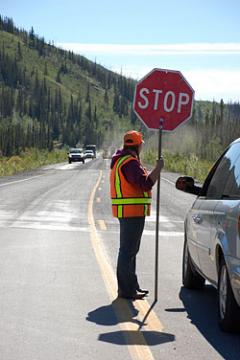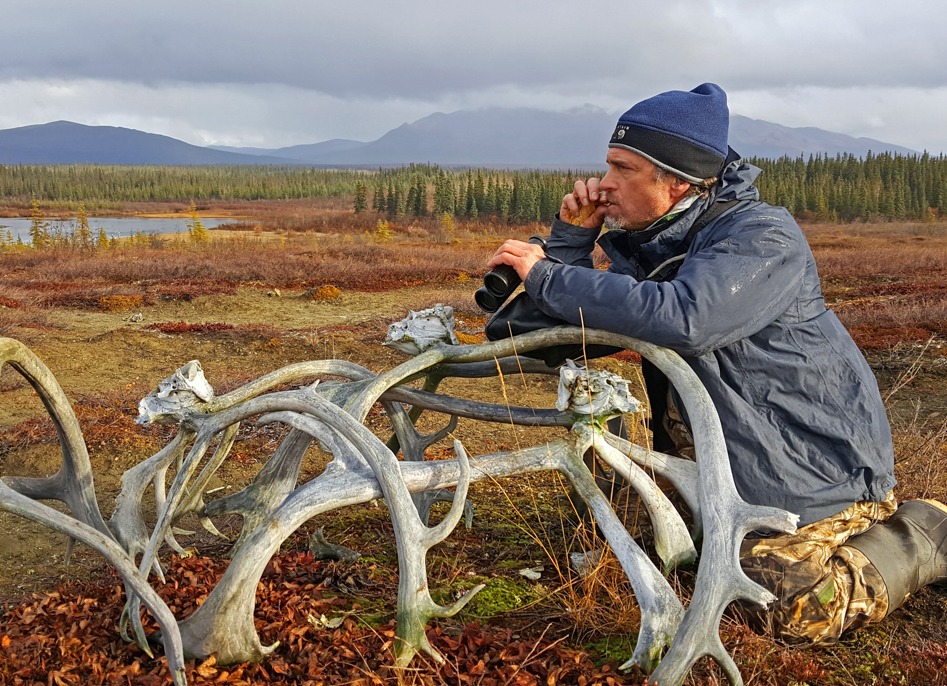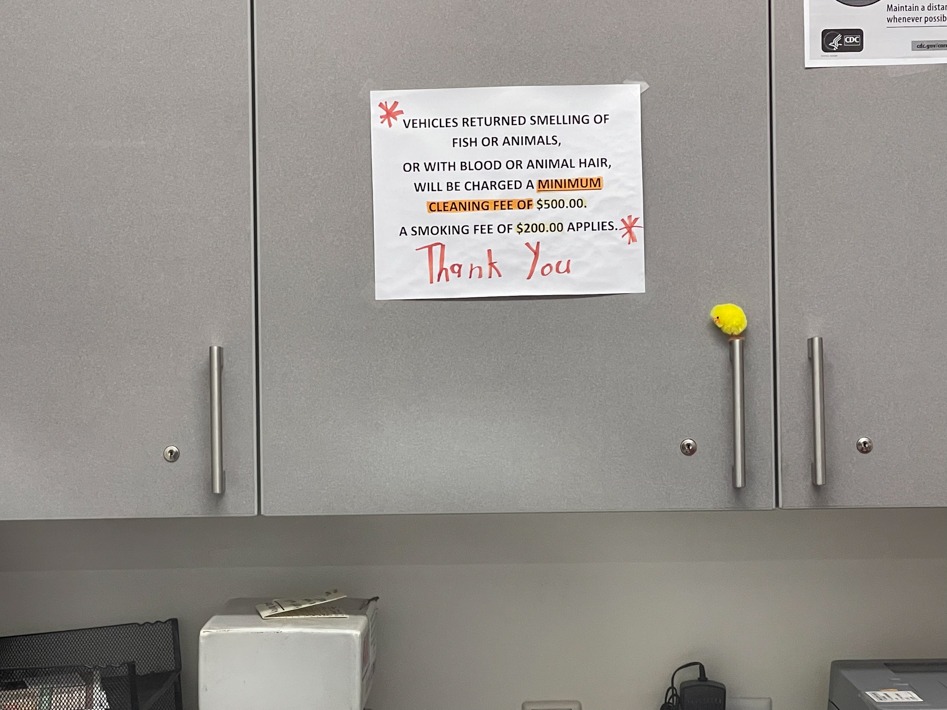Whether contemplating a trip up the Alaska Highway, or already packed and ready to go, travelers ask The MILEPOST® many of the same questions each year about what to expect along this pioneer road. And no wonder there are...
Whether contemplating a trip up the Alaska Highway, or already packed and ready to go, travelers ask The MILEPOST® many of the same questions each year about what to expect along this pioneer road.
And no wonder there are questions: The Alaska Highway traverses a vast wilderness in a remote expanse of North America, from Mile 0 at Dawson Creek, BC, to Delta Junction, AK, at Historical Mile 1422, official end of the Alaska Highway (which is 96 driving miles from Fairbanks, the unofficial end of the highway at Historical Mile 1523). Such a trip requires planning.
Following are the top ten most-frequently-asked questions about driving the Alaska Highway, and our answers.
1. Is the Alaska Highway paved? and 2. What are road conditions like?
 The short answers are “yes” and “mostly good.” The last section of original gravel road on the Alaska Highway was paved by 1992. That being said, you will still come across gravel road— “gravel breaks” that are anywhere from a few feet to a few miles long—where road repairs are under way. Road construction is a fact of life here in the summer, although delays are usually minimal.
The short answers are “yes” and “mostly good.” The last section of original gravel road on the Alaska Highway was paved by 1992. That being said, you will still come across gravel road— “gravel breaks” that are anywhere from a few feet to a few miles long—where road repairs are under way. Road construction is a fact of life here in the summer, although delays are usually minimal.
The asphalt surfacing of the Alaska Highway ranges from poor to excellent. Much of the highway is in fair condition, with older patched pavement and a minimum of gravel breaks and chuckholes. Recently upgraded sections of road offer excellent surfacing. Relatively few stretches of road fall into the “poor” category, i.e. chuckholes, gravel breaks, deteriorated shoulders, bumps and frost heaves. Damaged road is usually flagged with small orange flags or cones.
There’s a lot of straight road the first 300 miles of highway, between Dawson Creek and Fort Nelson. North of Fort Nelson, the Alaska Highway crosses the Rocky Mountains: Expect about 200 miles of narrow road with curves and hills with 10 percent grades and few passing lanes. This stretch of road crosses Summit Pass (Historic Milepost 392), highest summit on the Alaska Highway at 4,250 feet elevation. You may experience an odd snowstorm here, even in July. After winding through the MacDonald River valley—few guardrails and watch for caribou and stone sheep on the road—the highway straightens out again for the next 140 miles into Watson Lake, YT.
The stretch of road between Watson Lake and Whitehorse, approximately another 300 miles, is in fair to good condition, with easy curves through wide river valleys and along lakes.
From Whitehorse to Haines Junction, a distance of 100 miles, it is straight road with poor to fair surfacing with gravel breaks and frost heaves.
The next 200 driving miles, from Haines Junction to the Alaska border, consists of long straight stretches of improved highway with wide lanes and generous shoulders; an improved section that winds along the shore of Kluane Lake followed by and a long, often bumpy, frost-heaved stretch of road—in various stages of improvement—from Destruction Bay to the Alaska border.
From the Alaska–Yukon border to Tok, the Alaska Highway has curves and grades; it was in poor to fair condition in fall 2016. From Tok to Delta Junction, the highway is fairly straight and in fair to good condition, as was the Richardson-Alaska Highway between Delta Junction and Fairbanks. Both these sections of road have straight stretches interrupted by easy curves. Watch for moose.
3. What kind of vehicle should I take?
 Drive what you want to drive, just make sure it is mechanically sound with good tires (and a spare). You will see all sorts of vehicles traveling the Alaska Highway in summer, from bicycles, motorcycles, vintage and compact cars to pop-up trailers, motorhomes, 5th-wheelers towing passenger cars and plenty of trucks, big and small.
Drive what you want to drive, just make sure it is mechanically sound with good tires (and a spare). You will see all sorts of vehicles traveling the Alaska Highway in summer, from bicycles, motorcycles, vintage and compact cars to pop-up trailers, motorhomes, 5th-wheelers towing passenger cars and plenty of trucks, big and small.
The MILEPOST® field editors have driven a variety of vehicles on road logging trips, from a VW Eurovan to a Saturn, Subaru wagon, Honda CR-V and Pontiac Grand Am pulling a small trailer, to a 28-foot Class C motorhome. Field editors out of the Anchorage office currently drive a truck/camper.
4. What do I need to know about crossing the border?
U.S. and Canadian citizens are required to present one of the following travel documents as identification when crossing the U.S.–Canada border: U.S. or Canadian Passport, valid for air, land and sea travel; Passport Card (U.S. only), valid for land and sea travel; Enhanced Driver’s License (EDL), available in some states and provinces, valid for land and sea travel; or a Trusted Traveler program card (NEXUS, SENTRI or FAST/Expres), issued to pre-approved, low-risk travelers and valid for sea and land use. (NEXUS can also be used at participating airport kiosks.) Review “Know Before You Go” for more information.
If you are traveling with minors, you must carry proper identification for each child such as a birth certificate, passport, proof of citizenship, permanent resident card or Certificate of Indian Status. If you are not the parent or guardian of the children, you should also have written permission from the parent/guardian authorizing the trip. We strongly recommend that they have a letter from both parents (where applicable or whomever has guardianship of the child) detailing the length of stay, and identifying and authorizing who will take care of them while they are in Canada. The letter should include addresses and telephone numbers of where the parents or guardian can be reached.
U.S. motorists convicted of a criminal offense, such as Driving Under the Influence (DUI), may be refused entry into Canada or may be required to apply for admittance permits and pay fees.
Firearms: Canada vigorously enforces its firearms importation laws. Border officials may, at their discretion, search any vehicle for undeclared firearms and seize any vehicle and firearm where such firearms are found. Possession of an undeclared firearm may result in arrest or imprisonment. Go to this webpage for additional information to help you ascertain if your firearm would be permissible for transport and for the form that you can download, fill out, and be ready to present at the border, when you declare it. Phone 1-800-731-4000 with questions.
Firearms in Canada are classified as restricted, non–restricted or prohibited. ALL handguns are either restricted or prohibited. Visitors CANNOT import a prohibited firearm into Canada. They must be at least 18 to import other firearms.?Restricted firearms are only allowed to cross Canada and re-enter the United States or for approved purposes such as participation in target–shooting competitions where the importation is allowed for special purposes, with a temporary registration (nonresident fee of $25).
Pepper spray is allowed if it is clearly labeled as an animal repellent, e.g. bear spray. “Mace,” tasers and similar products intended to incapacitate a person are considered illegal weapons and are prohibited. Read additional information.
For additional details and documents required to lawfully import and possess firearms in Canada, as well as the rules for storing and transporting firearms, visit the Canada Firearms Centre online or phone 1-800-731-4000. See Canada Border Services Agency online for information on border controls.
Fireworks: An import permit issued by Natural Resources Canada is required. Additional information and forms are here.
The U.S. and Canada have restrictions and limitations that apply to importing alcohol, tobacco, meat, eggs, dairy products, fresh fruit, vegetables and other food and non-food items. Details on these items may be found at Canadian Customs and U.S. Customs. Canada also follows CITES guidelines regarding the import/export of endangered species of wild fauna and flora including parts or products.
Dogs and cats require proof of current vaccination against rabies and health certificates are recommended (issued not more than 30 days prior to crossing the border that state that your pet is healthy). While these certificates are not always reviewed, the lack of them may result in longer wait times at the border and even inadmissibility of your pet
Visit the Canada Border Services Agency online for more information. Access detailed information for both U.S. citizens and international visitors under the Travel menu on the U.S. Customs and Border Protection website.
5. Is cell phone and internet service available?
There are long stretches of the Alaska Highway without cell phone service. Service will also depend on your U.S. provider’s coverage in Canada or your Canadian provider’s coverage in the U.S.
Cell phone service providers in Alaska include AT&T, Verizon and GCI. T-Mobile subscribers can gain signal via the Alaska-owned GCI network. Coverage is, for the most part, confined to the highway system, although there is no coverage (outside major communities) along the Denali, Elliott, Steese or Dalton Highways (except for Deadhorse/Prudhoe Bay). There are also “dead zones” found along all highways. Coverage is increasing in bush villages and available in large communities.
Alaska provider coverage is spotty to nonexistent along the Alaska Highway in Yukon and northern British Columbia outside major communities like Whitehorse, Fort Nelson, Fort St. John and Dawson Creek. There is coverage in major communities from the Yellowhead Highway south along the West and Central Access Routes in British Columbia. Coverage is good in Alberta along the East Access Route. Canadian travelers in Alaska and visitors from the Lower 48 in both Canada and Alaska will need to check with their cellular service providers regarding coverage and application of roaming and/or international rates.
Cellular service in western Canada is provided by Bell and Telus. According to Yukon Tourism mobile phone coverage is available in all Yukon communities, but they suggest you check with your own mobile service provider to find out if yours will work in the Yukon. For the technically minded “Bell Mobility provides High Speed Packet Access (HSPA+) and Code Division Multiple Access (CDMA) digital cellular service in 17 Yukon communities.” There is no service provided for Globile System for Mobile (GSM) phones.
WiFi and hardwired internet access is available at many hotels/motels and campgrounds along the Alaska Highway, as well as at some visitor centers, libraries and coffee shops/cafes.
6. How far apart are services?
Gas, diesel, food and lodging are found in towns and cities along the Alaska Highway, as well as at smaller unincorporated communities, roadhouses and lodges located between the larger population centers. With the closure of several long-time roadhouses in recent years, and the seasonal nature of others, motorists should plan for 100 to 150 miles between services on a couple stretches of highway. Pay attention to your gas tank and drive on the top half of your tank. Motorists should also keep in mind that not all highway businesses are open year-round, nor are most services available 24 hours a day.
Remember that you will be driving in 2 different countries that use 2 different currencies: For the best rate, exchange your money at a bank. There are banks in Dawson Creek, Fort St. John, Fort Nelson, Watson Lake, Whitehorse, Tok, Delta Junction and Fairbanks. Haines Junction has banking service at the post office. Most businesses (but not all) will take major credit cards. Be aware that many credit card companies tack on a fee for foreign currency transactions.
7. How about lodging? Do we need reservations?
It’s always a good idea to call ahead for a room. Small to mid-sized communities along the Alaska Highway often have limited accommodations that can fill up with gas patch and road crews as well as tourists. It can get just as busy at the larger communities along the highway during the summer. If you don’t want to plan too far ahead, at least call a day or two in advance to arrange for accommodations.
8. How about campgrounds?
There are many private RV parks and campgrounds along the Alaska Highway, as well as government campsites. British Columbia has 6 provincial park campgrounds on the Alaska Highway; Yukon maintains 8 government campgrounds; and in Alaska there are 10 state and federal recreation sites for camping along the Alaska Highway.
Plan to pull in in the afternoon to make sure you get a spot. During the high-season (mid-summer), certain campgrounds can fill up early in the day.
The weather can include below freezing temperatures well into May. Campgrounds in many areas of Yukon and Alaska interior remain closed until mid-to late May (or offer reduced services) because of frozen water lines.
9. When is the best time to go?
 The Alaska Highway is driven year-round, although most tourist traffic hits the road between May and September. Expect ice on Kluane Lake in May, and there’s always the possibility of a brief snow or hail storm—even in mid-summer—around Summit Lake in the Rockies, although we’re talking about only a few miles of extreme weather.
The Alaska Highway is driven year-round, although most tourist traffic hits the road between May and September. Expect ice on Kluane Lake in May, and there’s always the possibility of a brief snow or hail storm—even in mid-summer—around Summit Lake in the Rockies, although we’re talking about only a few miles of extreme weather.
It “greens up” in the latter part of May in the North, and the leaves begin to turn as early as August in the Interior. Expect cold nights (freezing and below) by early September in parts of Yukon and Interior Alaska. Keep in mind that some attractions and businesses in the North operate seasonally, opening around Memorial Day weekend and closing after Labor Day weekend.
June and July offer lots of daylight, with summer solstice on or around June 21st. This gives you extra-long days for driving, fishing, hiking and sightseeing. May and June tend to be drier than July, but in the North as elsewhere, weather is unpredictable. Along with warm temps and long days you can expect bugs. Bring repellent for yourself and any furry family members to make your stops more enjoyable.
10. What are winter driving conditions?
Staff frequently receives questions about driving the Alaska Highway in winter from people curious about Alaska winters, the northern lights and winter tourism opportunities. Military families and others who move to or from Alaska in the off-season are also curious to know how to ensure they have a safe trip despite winter road conditions and possible extreme temperatures. Our in-house and field editorial staff have driven the Alaska Highway many times in winter and report that the road surfaces are smoother and there is no dust or construction, the wildlife viewing includes plenty of variety (just not bears) and it is easier to spot wildlife on the road as they stand out against the white snow. We enjoy the peacefulness of roads with less traffic and the expansive beauty of snow covered wide open spaces, frozen lakes, ribbons of rivers and majestic mountains. We recommend specific preparations and resources to help you plan for a winter trip on the Alaska Highway.
Studded tires are legal in Alaska from Sept. 15–May 1 and from Oct. 1–April 30 in BC. Yukon’s rules on studded tires are in conjunction with Alaska and BC dates. BC also requires passenger vehicles to use winter tires on BC Highways from Oct. 1–March 31 and you may be delayed, have your car impounded or get fined if you are not in compliance. While studded tires aren’t essential, good winter tires are recommended (and required by BC) as snow and likely ice, is the norm. Road conditions should always be a concern and asking what’s up ahead as you drive along is prudent. Be willing to spend the night if the weather doesn’t cooperate with your travel plans. Crews in these northern areas are well equipped to handle winter weather and roads are quickly cleared and ready for traffic after storms.
Here is a list of road report phone numbers, websites and weather cams that show stretches of the roads so that you can look ahead at what is to come: For Alaska road conditions go to 511 Alaska and be sure to check the box for weather cameras which will show you all the cam views possible on Alaska roads. By hovering over the icons on the map you can read current weather conditions. Phone 511 for recorded weather conditions on Alaska roads. For Yukon road conditions go to 511 Yukon or phone 511 or 867-456-7623. For British Columbia road conditions go to Drive BC; web cams at: BC Highway web cams or phone 800-550-4997 or cell *4887. For Northwest Territories road reports go to Northwest Territories highway conditions or phone 800-550-0750. For Alberta road conditions go to 511 Alberta and click on the map for conditions or phone 511 or 855-391-9743.
Much of this route includes remote miles. To help with anticipating the unknown, plan to gas up frequently. Even in winter there are gas stations open at reasonable distances but few are open 24-hours. Drive on the top half of your tank—which means, fill up whenever you get near a half-tank—just to be safe. Phone ahead for lodging to make sure you don’t arrive during an unexpected closure for the owners (even for year-round businesses). Have a block heater installed in your vehicle and keep your extension cord handy for plugging in if the weather is below zero. Keep all of your emergency road gear at the top of your load and within easy reach in an emergency. Be sure to have flares, jumper cables, a tow rope, all tire changing equipment and heavy outdoor gear for extreme temperatures, all handy just in case you need them. You don’t want to have to unpack your vehicle just to reach the car jack, if it is -20F and you get a flat. Above all, if you are stopped along the road and unable to fix your vehicle, set out emergency flares to alert traffic to your situation and then stay in your car till help comes. Keep sleeping bags, food and water handy to increase the likelihood of a comfortable wait. Travelers help each other in these northern climates and we have seen tractor trailers pull up, latch on and pull out cars from a snowbank, then drive off with nothing more than a wave. Your emergency equipment may help others in need but be sure you don’t cause an accident when you stop to help. Pull well out of the way of traffic and ensure you are visible to those approaching and from behind by setting out flares (or flags) as far in advance and behind as possible to alert other drivers to slow down.
For those of you from southern climates, freezing temps overnight—when your car is turned off—can affect your cargo. Remember to bring electronics, or at least their batteries, inside with you each night along your trip. Freezing temps wreak havoc on their integrity and can explode canned goods or beverages you may have with you so plan to bring them in with you when you stop for the night. Rule of thumb, if putting something in the freezer would harm it, you don’t want to leave it in your car. (NOTE: your car battery is not in danger but you should have it checked for charge prior to this trip as freezing temps put more of a strain on it than normal temps.)
Once you have prepared for the worst, prepare to enjoy your drive. Drive at the speed dictated by highway conditions, keep your camera handy and take frequent breaks. This winter drive will be an adventure of a lifetime and you want the photos to prove it!
The post FAQ: Driving the Alaska Highway appeared first on The MILEPOST.















